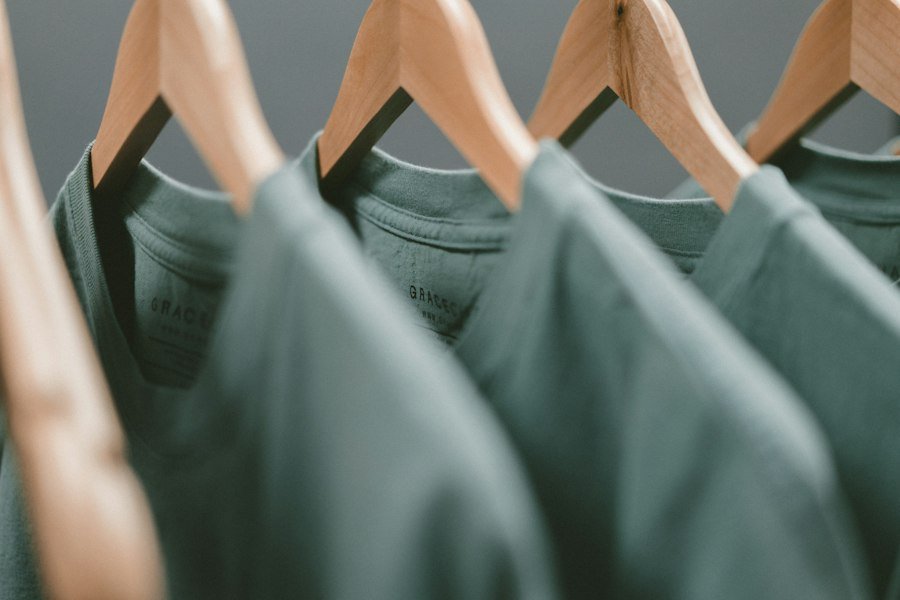In recent years, there has been a growing movement towards eco-chic and sustainable fashion. As consumers become more aware of the negative impact of fast fashion on the environment and society, they are seeking out alternatives that are both stylish and sustainable. Eco-chic fashion choices are not only a way to express personal style, but also a way to make a positive impact on the planet.
Making sustainable fashion choices is important for several reasons. First and foremost, the fashion industry is one of the largest contributors to pollution and waste. The production of clothing involves the use of toxic chemicals, excessive water consumption, and the release of greenhouse gases. Additionally, the fast fashion model encourages overconsumption and disposable clothing, leading to a cycle of waste and environmental degradation.
The Importance of Sustainable Fashion
The negative impact of fast fashion on the environment and society cannot be overstated. The fashion industry is responsible for a significant amount of pollution, including water pollution from dyeing processes and chemical runoff, as well as air pollution from textile production and transportation. In addition, the fashion industry is notorious for its exploitative labor practices, with many garment workers being paid low wages and working in unsafe conditions.
Sustainable fashion offers a solution to these problems by promoting ethical production practices and reducing waste. By choosing sustainable fashion options, consumers can support brands that prioritize fair labor practices, use environmentally friendly materials, and promote transparency in their supply chains. This not only helps to protect the planet, but also ensures that workers are treated fairly and paid a living wage.
Understanding Eco-Fashion and Its Impact on the Environment
Eco-fashion, also known as sustainable fashion or ethical fashion, is a movement within the fashion industry that aims to minimize its environmental impact and promote social responsibility. Unlike conventional fashion, which often prioritizes profit over sustainability, eco-fashion takes into account the entire lifecycle of a garment, from production to disposal.
One of the key differences between eco-fashion and conventional fashion is the use of environmentally friendly materials. Eco-fashion brands often use organic or recycled materials, such as organic cotton, hemp, and recycled polyester. These materials are grown or produced without the use of harmful chemicals and have a lower impact on the environment compared to traditional fabrics.
In addition to using sustainable materials, eco-fashion also focuses on reducing waste and pollution throughout the production process. This includes minimizing water consumption, using non-toxic dyes, and implementing recycling and upcycling initiatives. By taking these steps, eco-fashion brands are able to create clothing that is not only stylish, but also better for the planet.
The Rise of Eco-Friendly Fabrics and Materials in Fashion
In recent years, there has been a surge in the popularity of eco-friendly fabrics and materials in the fashion industry. These materials offer a more sustainable alternative to traditional fabrics, which are often made from non-renewable resources and require large amounts of water and energy to produce.
One of the most popular eco-friendly fabrics is organic cotton. Unlike conventional cotton, which is grown using large amounts of pesticides and synthetic fertilizers, organic cotton is grown without the use of harmful chemicals. This not only reduces the environmental impact of cotton production, but also helps to protect the health of farmers and workers.
Another eco-friendly fabric that is gaining popularity is Tencel, also known as lyocell. Tencel is made from wood pulp sourced from sustainably managed forests. The production process for Tencel uses less water and energy compared to traditional fabrics, making it a more sustainable choice.
Other eco-friendly materials used in sustainable fashion include hemp, bamboo, and recycled polyester. Hemp is a highly sustainable crop that requires little water and no pesticides to grow. Bamboo is a fast-growing plant that can be harvested without killing the plant, making it a renewable resource. Recycled polyester is made from recycled plastic bottles and reduces the demand for virgin polyester, which is derived from non-renewable resources.
The Benefits of Investing in Sustainable Fashion
Investing in sustainable fashion offers a range of benefits, both for individuals and for the planet. One of the key benefits is the potential for long-term cost savings. While sustainable fashion may have a higher upfront cost compared to fast fashion, the quality and durability of sustainable clothing often means that it will last longer. This means that over time, consumers can save money by not having to constantly replace worn-out or low-quality clothing.
In addition to cost savings, investing in sustainable fashion also helps to reduce waste. By choosing high-quality, timeless pieces that can be worn for years to come, consumers can avoid contributing to the cycle of disposable fashion. This not only reduces the amount of clothing that ends up in landfills, but also helps to conserve resources and reduce pollution associated with the production and disposal of clothing.
Building a more ethical and conscious wardrobe is another benefit of investing in sustainable fashion. By supporting brands that prioritize fair labor practices and transparency in their supply chains, consumers can feel good about their purchasing decisions. This also allows individuals to align their personal values with their fashion choices, creating a wardrobe that reflects their commitment to sustainability and social responsibility.
Tips for Building a Sustainable Wardrobe

Building a sustainable wardrobe doesn’t have to be overwhelming or expensive. There are several practical tips that can help individuals make more sustainable fashion choices and build a wardrobe that is both stylish and eco-friendly.
One of the easiest ways to build a sustainable wardrobe is to buy secondhand. Thrift stores, consignment shops, and online platforms like Poshmark and Depop offer a wide range of pre-loved clothing at affordable prices. Buying secondhand not only reduces waste by giving clothing a second life, but also allows individuals to find unique and one-of-a-kind pieces that can’t be found in traditional retail stores.
Investing in high-quality pieces is another key tip for building a sustainable wardrobe. While sustainable fashion may have a higher upfront cost, the durability and longevity of these pieces often make them a worthwhile investment. Look for well-made garments with strong stitching and quality materials that will stand the test of time.
Making the most of your existing wardrobe is also an important aspect of building a sustainable wardrobe. Instead of constantly buying new clothes, try mixing and matching items to create new outfits. Experiment with different combinations and accessories to create fresh looks without buying new clothing.
Sustainable Fashion Brands to Know and Support
There are a growing number of sustainable fashion brands that are worth knowing and supporting. These brands prioritize ethical production practices, use environmentally friendly materials, and promote transparency in their supply chains.
One example of a sustainable fashion brand is Patagonia. Known for its commitment to environmental and social responsibility, Patagonia uses recycled materials, organic cotton, and fair trade practices in its production processes. The brand also encourages customers to repair their clothing instead of buying new items, further reducing waste.
Another sustainable fashion brand is Everlane. Everlane is known for its transparent pricing model, which breaks down the cost of each item to show customers exactly how much they are paying for materials, labor, and overhead. The brand also focuses on using high-quality materials and partnering with ethical factories to ensure fair labor practices.
For those on a budget, there are also affordable sustainable fashion brands available. One example is People Tree, a fair trade brand that offers stylish and affordable clothing made from organic cotton and other sustainable materials. Another budget-friendly option is Pact, which specializes in organic cotton basics at affordable prices.
How to Incorporate Trending Fashion into Your Sustainable Wardrobe
Staying on-trend while making sustainable fashion choices is easier than ever. Many sustainable fashion brands are now offering trendy and fashionable pieces that are made with ethical and sustainable practices.
One way to incorporate trending fashion into your sustainable wardrobe is to focus on timeless and versatile pieces. Instead of chasing every passing trend, invest in classic pieces that can be worn season after season. This not only reduces waste, but also ensures that your wardrobe remains stylish and relevant for years to come.
Another way to stay on-trend while making sustainable fashion choices is to focus on accessories. Accessories can instantly update an outfit and add a trendy touch without the need to buy new clothing. Look for sustainable accessories, such as jewelry made from recycled materials or bags made from vegan leather.
Eco-Chic Accessories: Sustainable and Stylish Additions to Your Outfit
Choosing sustainable accessories is just as important as choosing sustainable clothing. Accessories, such as jewelry, bags, and shoes, can have a significant impact on the overall sustainability of an outfit.
When it comes to jewelry, look for brands that use recycled materials or ethically sourced gemstones. Brands like Mejuri and Catbird offer a range of sustainable and stylish jewelry options that are perfect for adding a touch of eco-chic to any outfit.
For bags, opt for brands that use vegan leather or recycled materials. Matt & Nat is a popular brand that offers a range of stylish and sustainable bags made from vegan leather. Another option is Baggu, which specializes in reusable bags made from recycled materials.
When it comes to shoes, look for brands that prioritize ethical production practices and use sustainable materials. Brands like Veja and Allbirds offer a range of stylish and sustainable footwear options that are perfect for the conscious leader.
The Future of Sustainable Fashion and Its Role in the Fashion Industry
The future of sustainable fashion looks promising. As consumers become more aware of the negative impact of fast fashion, they are demanding more sustainable options from brands. This has led to a shift in the fashion industry, with many brands now incorporating sustainable practices into their production processes.
Sustainable fashion is also becoming more mainstream, with celebrities and influencers using their platforms to promote eco-friendly brands and encourage sustainable fashion choices. This increased visibility and awareness is helping to normalize sustainable fashion and make it more accessible to a wider audience.
In addition, advancements in technology and innovation are driving the development of new sustainable materials and production methods. From lab-grown fabrics to 3D printing, these innovations have the potential to revolutionize the fashion industry and make sustainable fashion the norm rather than the exception.
In conclusion, eco-chic and sustainable fashion choices are not only a way to express personal style, but also a way to make a positive impact on the planet. By choosing sustainable fashion options, consumers can support brands that prioritize fair labor practices, use environmentally friendly materials, and promote transparency in their supply chains. Building a sustainable wardrobe doesn’t have to be overwhelming or expensive. By buying secondhand, investing in high-quality pieces, and making the most of your existing wardrobe, you can create a stylish and eco-friendly wardrobe that reflects your commitment to sustainability.
